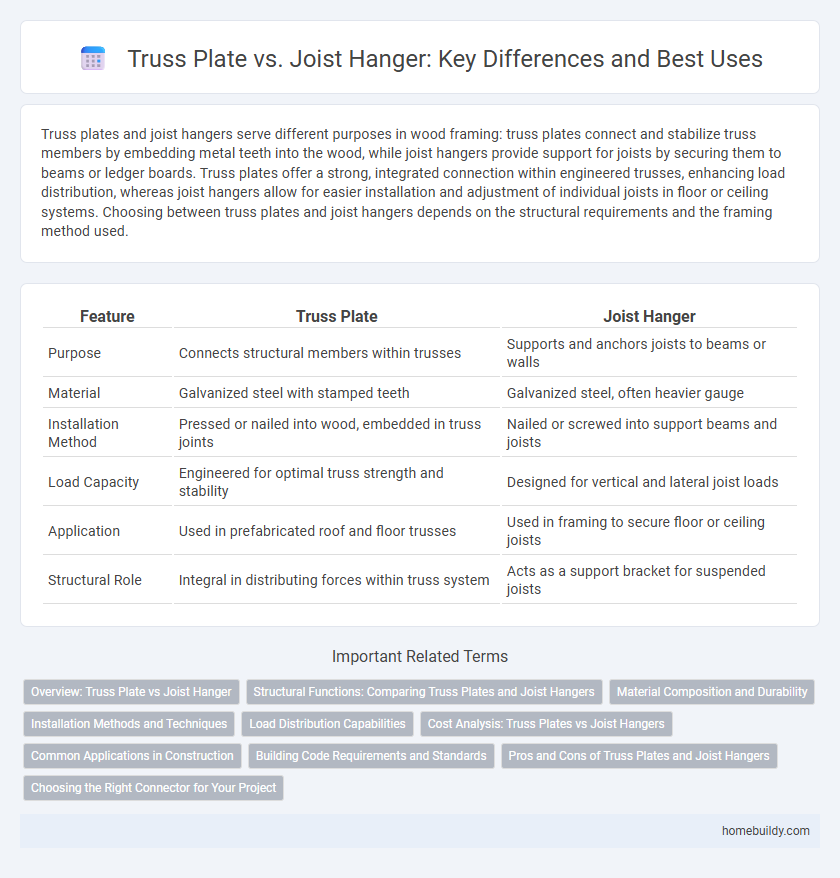Truss plates and joist hangers serve different purposes in wood framing: truss plates connect and stabilize truss members by embedding metal teeth into the wood, while joist hangers provide support for joists by securing them to beams or ledger boards. Truss plates offer a strong, integrated connection within engineered trusses, enhancing load distribution, whereas joist hangers allow for easier installation and adjustment of individual joists in floor or ceiling systems. Choosing between truss plates and joist hangers depends on the structural requirements and the framing method used.
Table of Comparison
| Feature | Truss Plate | Joist Hanger |
|---|---|---|
| Purpose | Connects structural members within trusses | Supports and anchors joists to beams or walls |
| Material | Galvanized steel with stamped teeth | Galvanized steel, often heavier gauge |
| Installation Method | Pressed or nailed into wood, embedded in truss joints | Nailed or screwed into support beams and joists |
| Load Capacity | Engineered for optimal truss strength and stability | Designed for vertical and lateral joist loads |
| Application | Used in prefabricated roof and floor trusses | Used in framing to secure floor or ceiling joists |
| Structural Role | Integral in distributing forces within truss system | Acts as a support bracket for suspended joists |
Overview: Truss Plate vs Joist Hanger
Truss plates and joist hangers are essential components in wood framing, serving distinct structural purposes. Truss plates are metal connectors used primarily to join multiple wooden members within a truss assembly, providing load distribution and stability across roof or floor frameworks. Joist hangers support and secure individual joists to beams or headers, ensuring proper alignment and load transfer in floor and ceiling construction.
Structural Functions: Comparing Truss Plates and Joist Hangers
Truss plates are engineered metal connectors designed to join multiple wood members in truss assemblies, providing rigid and uniform load distribution across joints. Joist hangers support individual joists by securing them to beams or ledger boards, primarily resisting vertical loads and preventing rotation. While truss plates enable the creation of complex truss frameworks with high axial strength, joist hangers excel in supporting horizontal floor or ceiling joists, enhancing structural stability through direct bearing and load transfer.
Material Composition and Durability
Truss plates are typically made from galvanized steel, offering superior corrosion resistance and long-lasting durability in wood-to-wood connections. Joist hangers, often constructed from stainless steel or zinc-plated steel, provide robust support for wood-to-wood or wood-to-metal joints but may be less resistant to harsh environmental conditions compared to galvanized truss plates. The choice between truss plates and joist hangers hinges on the specific load requirements, environmental exposure, and desired lifespan of the structural joint.
Installation Methods and Techniques
Truss plates are installed by pressing the metal plate onto the truss joint, using hydraulic presses or specialized pneumatic tools to ensure the teeth fully embed into the timber for a secure connection. Joist hangers require nailing or screwing the metal bracket onto a supporting beam and the joist, typically involving pre-drilled holes to guide fasteners for a precise and strong hold. While truss plate installation focuses on embedding teeth for load distribution across wood members, joist hanger installation emphasizes mechanical fastening for removable and adjustable connections.
Load Distribution Capabilities
Truss plates provide efficient load distribution by connecting multiple wooden members, ensuring uniform stress transfer across the joint for enhanced structural stability. In contrast, joist hangers primarily support vertical loads on individual beams, concentrating forces at the hanger interface and potentially creating stress points. The superior load distribution capabilities of truss plates make them ideal for complex truss assemblies where even load spread is critical.
Cost Analysis: Truss Plates vs Joist Hangers
Truss plates generally offer a more cost-effective solution for wood frame connections compared to joist hangers, especially in large-scale projects due to their lower material and installation expenses. Joist hangers tend to have higher upfront costs driven by hardware prices and labor-intensive installation processes. When analyzing long-term affordability, truss plates reduce overall expenses through faster assembly and less specialized labor requirements, making them the preferred choice for budget-conscious builders.
Common Applications in Construction
Truss plates are primarily used to connect wood truss members in roof and floor systems, providing structural stability by distributing loads evenly at joints. Joist hangers are designed to support and anchor horizontal joists to beams or ledger boards, commonly used in floor framing and deck construction. Both components ensure secure connections but are selected based on whether the application involves truss assembly or joist support.
Building Code Requirements and Standards
Truss plates and joist hangers must comply with specific building code requirements to ensure structural safety and reliability. Building codes such as the International Building Code (IBC) and standards like ASTM A653 dictate the material properties, load capacities, and installation methods for both hardware types. Proper adherence to these codes ensures that truss plates provide secure nail connections within engineered wood trusses, while joist hangers effectively support and transfer load between joists and beams.
Pros and Cons of Truss Plates and Joist Hangers
Truss plates provide strong, cost-effective connections ideal for prefabricated wood trusses but can be less versatile in on-site adjustments compared to joist hangers. Joist hangers offer flexible, easy-to-install support for joists and beams, accommodating various angles and timber sizes, although they may require more hardware and labor. Choosing between truss plates and joist hangers depends on project-specific factors like load requirements, installation speed, and structural design complexity.
Choosing the Right Connector for Your Project
Truss plates provide strong, efficient connections for prefabricated roof trusses by securely joining multiple members with minimal fabrication time. Joist hangers are ideal for supporting individual joists where beams and joists meet, offering easy installation and reliable load transfer in open framing applications. Selecting between truss plates and joist hangers depends on structural requirements, load capacity, and the specific framing configuration of your construction project.
Truss plate vs Joist hanger Infographic

 homebuildy.com
homebuildy.com